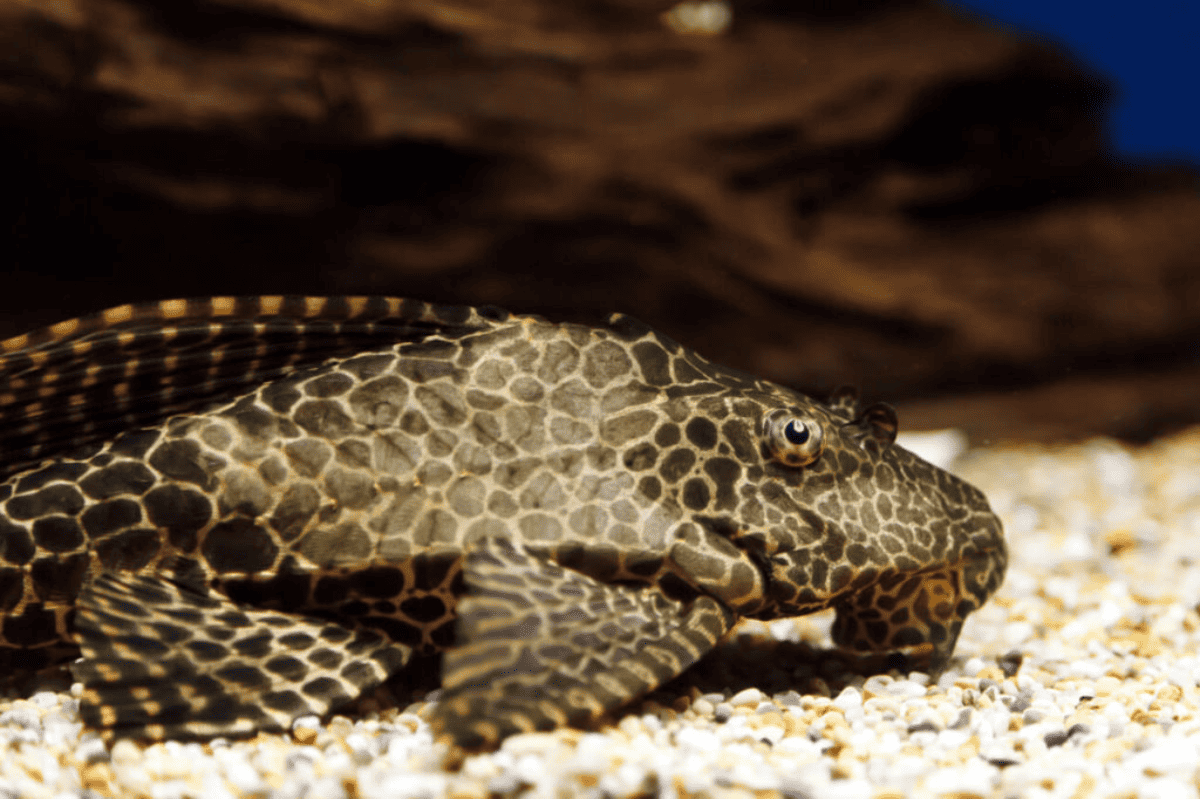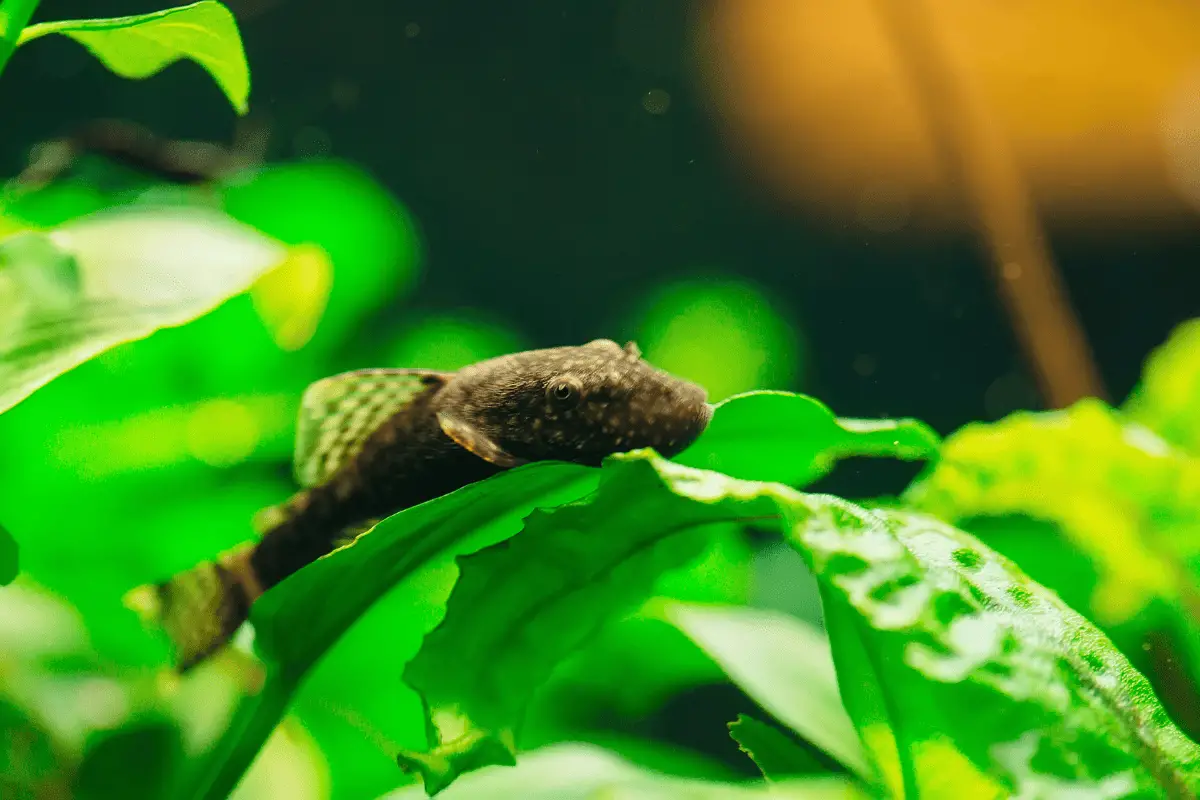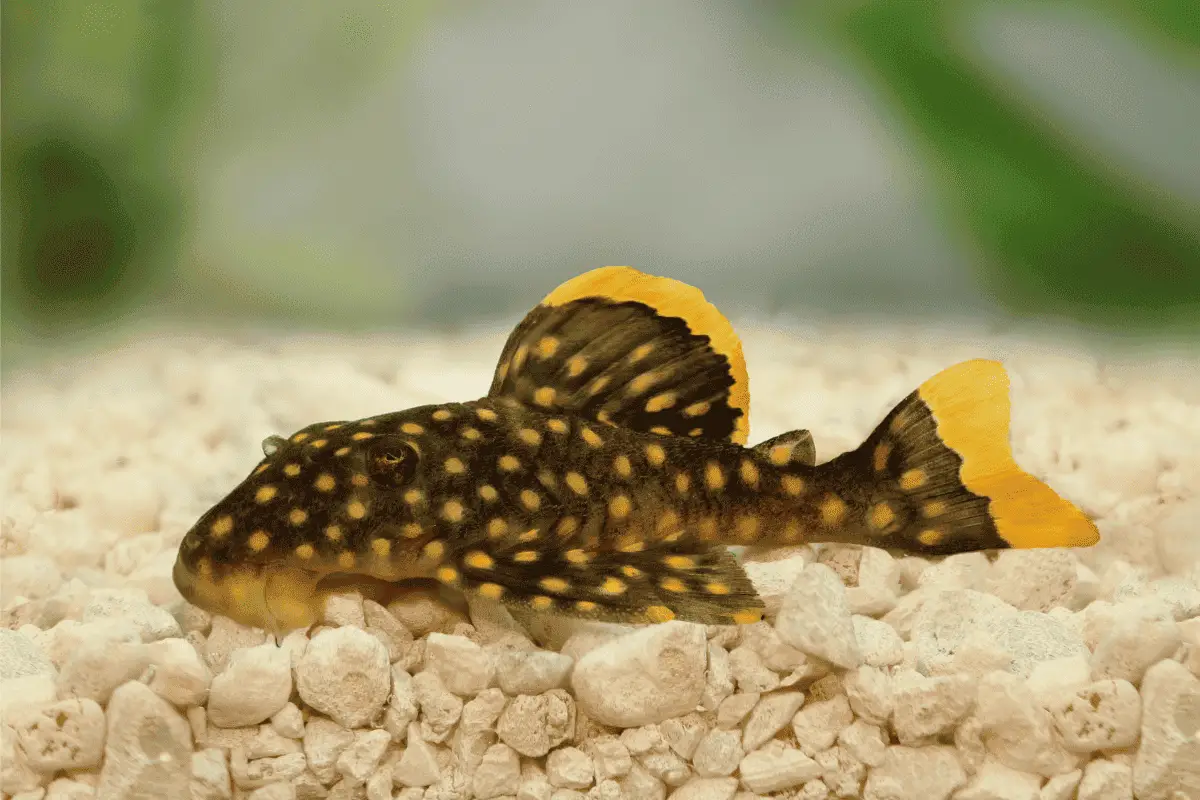Both Plecos and Platies are popular choices in freshwater aquariums. But can they actually live together in the same tank?
What factors should you consider when keeping them both together? What about the tank setup, water requirements, and feeding habits of both types?
Which Pleco species are suitable for this mixture, and which species should you avoid? And what about additional tank mates?
In this article, I’ll discuss all these questions and more, so you’ll leave with all the information you need. Let’s get started.

Can I Keep Plecos and Platies Together in the Same Tank?
Yes, you can keep Plecos and Platies together in the same tank. Both species generally coexist peacefully if their needs are met.
- Compatibility: Plecos are bottom dwellers and Platies are mid-water swimmers, so they occupy different tank regions, reducing territorial disputes.
- Diet Differences: While Plecos mainly feed on algae and sinking pellets, Platies prefer flake foods and small live foods, preventing competition for the same food sources.
- Tank Size: Plecos, especially common ones, can grow up to 24 inches, requiring a minimum of 125 gallons. Ensure the tank is spacious enough for both species to thrive.
- Water Parameters: Both Plecos and Platies prefer slightly alkaline water, with pH levels between 7.0 to 8.0, allowing for shared water conditions.
- Behavioral Traits: Plecos are generally docile and not aggressive towards smaller fish, making them suitable tank mates for the peaceful Platies.
Also Read: Pleco Fish Tank Mates
Plecos vs. Platies: Behavior
The first thing to think about is how Plecos and Platies naturally act. Here’s what you should be aware of:
Pleco Fish: Natural Behavior
Plecos are mainly night owls, coming to life after dark to feed and explore. They’re usually pretty chill, hanging out at the bottom of the tank and minding their own business.
- Nighttime Activity: Plecos are most active at night, searching for food and scraping algae off surfaces.
- Sticky Mouths: They have specialized mouths that let them stick to surfaces, which helps them munch on algae-covered ornaments and glass.
- Lone Wolves: Although Plecos can live with other fish, they usually like to be alone and don’t interact much with others.
- Territory Issues: Especially when it comes to other Plecos, they can get territorial, guarding their favorite hiding places or rest spots.

Platy Fish: Natural Behavior
Platies are energetic, middle-of-the-tank swimmers who love exploring. They’re usually laid-back and get along well with other community fish.
- Daytime Hangouts: Unlike Plecos, Platies are day-active and you’ll often see them swimming around in daylight.
- Squad Goals: Platies are social fish and it’s a good idea to keep them in small groups.
- Baby Boomers: Platies breed rapidly, usually having live babies every month.
- Foodies: They eat a variety of foods like flake food, tiny live foods, and even some plants, showing off their omnivorous tastes.

Ideal Parameters for Plecos and Platies
When it comes to water parameters, both Plecos and Platies thrive in specific conditions.
The following table provides a concise breakdown of these parameters for each fish type and a combined setup:
| Parameter | Plecos | Platies | Both Types |
| Temperature | 74°F – 80°F (23°C – 27°C) | 70°F – 78°F (21°C – 26°C) | 74°F – 78°F (23°C – 26°C) |
| pH Level | 6.5 – 7.5 | 7.0 – 8.0 | 7.0 – 7.5 |
| Water Hardness | 6 – 10 dGH | 10 – 25 dGH | 10 – 15 dGH |
Pleco Fish: Ideal Parameters
Plecos thrive in stable water conditions that mimic their native South American habitats. Specific parameters may vary by species, but here’s a general guideline.
- Temperature: Plecos prefer warmer waters, with temperatures ranging between 72°F to 86°F (22°C to 30°C).
- pH Level: They thrive in a pH range of 6.5 to 7.5, leaning towards slightly acidic to neutral water.
- Water Hardness: Soft to moderately hard water, within a dGH of 4 to 20, suits most Pleco species best.

Platy Fish: Ideal Parameters
Platies originate from Central and South America, and while they’re adaptable, they do have specific preferences for optimum health.
- Temperature: Platies are comfortable in temperatures ranging from 70°F to 78°F (21°C to 25.5°C).
- pH Level: They prefer slightly alkaline water conditions, with a pH between 7.0 and 8.0.
- Water Hardness: Platies are adaptable but generally prefer moderately hard water, with a dGH between 10 to 25.

Plecos vs. Platies: Tank Setup
Maintaining an ideal tank setup is pivotal for the health and well-being of Plecos and Platies.
Here’s a table outlining the key elements of their individual setups and what to consider for a shared tank:
| Setup Element | Plecos | Platies | Both Types |
| Ammonia | 0 ppm | 0 ppm | 0 ppm |
| Nitrite | 0 ppm | 0 ppm | 0 ppm |
| Nitrate | <40 ppm | <40 ppm | <40 ppm |
| Tank Size | Min. 20 gallons per Pleco | 10-20 gallons | Min. 30 gallons |
| Foliage | Plants for hiding | Floating plants | Combination of both |
| Decorations | Driftwood and caves | Rocks and ornaments | Blend of both for diverse environment |
| Filter | Strong filtration | Moderate filtration | Strong filtration |
| Heater | Required | Optional, depending on temp | Required |
| Substrate | Fine gravel or sand | Gravel or sand | Fine gravel |
| Pump | Moderate to strong flow | Moderate flow | Moderate to strong flow |
| Lighting | Moderate | Moderate to bright | Moderate |
Pleco Fish: Tank Setup
Plecos, given their potential size and unique habits, require a specialized environment to ensure their well-being. They need spacious, well-filtered tanks with multiple hiding spots.
- Ammonia Nitrite Nitrate: Maintaining low levels is crucial; Plecos are sensitive to high concentrations of these compounds.
- Tank Size: Common Plecos require large tanks, often at least 125 gallons, due to their potential growth up to 24 inches.
- Foliage: Live plants, like Java Fern or Anubias, can provide natural grazing areas for Plecos.
- Decorations: Caves, driftwood, and hiding spots are vital for Pleco security and well-being.
- Filter: A robust filtration system is essential, as Plecos produce significant waste.
- Heater: A stable temperature between 72°F to 86°F (22°C to 30°C) requires a reliable heater.
- Substrate: Sand or fine gravel allows Plecos to scavenge comfortably.
- Pump: A good water circulation supports Plecos’ respiratory needs.
- Lighting: Dimmer lighting or lots of shade can mimic Plecos’ natural, murky riverbed environment.

Platy Fish: Tank Setup
Platies are versatile and can thrive in various tank settings. They do appreciate vibrant environments with enough space to swim and explore.
- Ammonia Nitrite Nitrate: Like all fish, Platies need these compounds kept at minimal levels for good health.
- Tank Size: A 10-gallon tank is suitable for a small group, but larger is better for their active nature.
- Foliage: Plants like Hornwort or Water Sprite offer shelter and breeding spots for Platies.
- Decorations: While they aren’t as cave-dependent as Plecos, Platies enjoy hideouts and ornaments.
- Filter: A moderate filtration system helps keep the water clear and oxygen-rich.
- Heater: A temperature range of 70°F to 78°F (21°C to 25.5°C) keeps Platies content.
- Substrate: Fine gravel or sand substrates are ideal for the tank’s bottom.
- Pump: Adequate water flow ensures a well-oxygenated environment for Platies.
- Lighting: Moderate to bright lighting accentuates the vibrant colors of Platies.

The Dietary Requirements of Plecos and Platies
The dietary needs of Plecos and Platies are distinct, but in a combined tank, you can strike a balance. This table summarizes their food preferences and the approach for a mixed tank:
| Dietary Aspect | Plecos | Platies | Both Types |
| Food Types | Algae wafers, veggies, driftwood | Omnivore flakes, live food | Offer a mix of both types |
| Quantity | 2-3 wafers per Pleco | Small pinches 1-2x/day | Adjust based on fish count and consumption |
| Feeding Schedule | 2-3 times a week | Once daily | Adjust timing for both species’ needs |
Pleco Fish: Ideal Dietary Requirements
Plecos have a varied diet, primarily consisting of algae, but they also need supplemental nutrition for balanced health. Quality and variety are essential for their well-being.
- Food Types: Algae wafers, vegetables (like zucchini), and high-quality sinking pellets cater to their dietary needs.
- Quantity: Depending on the Pleco size, a few wafers or a small veggie slice daily suffice.
- Feeding Schedule: Given their nocturnal nature, feeding Plecos in the evening is optimal.

Platy Fish: Ideal Dietary Requirements
Platies are omnivores with a preference for small live foods, flakes, and some plant matter. They thrive when offered a diverse diet.
- Food Types: Quality flake food, brine shrimp, and finely chopped vegetables offer balanced nutrition.
- Quantity: A pinch of flakes or equivalent, ensuring it’s consumed in a few minutes, is sufficient.
- Feeding Schedule: Feeding Platies 1-2 times a day in small amounts ensures optimal health without overfeeding.

Pleco Species Most Suitable for a Tank With Platies
For a harmonious tank environment with Platies, it’s wise to choose Pleco species that remain relatively small and have a docile disposition.
Several Pleco species are particularly compatible with Platies due to their size and behavior.
- Bristlenose Plecos (Ancistrus spp.): These Plecos stay under 6 inches and are non-aggressive, making them perfect companions.
- Clown Plecos (Panaqolus maccus): With a size of about 3.5 to 4 inches, these Plecos are not only compact but also peaceful.
- Rubber Lip Plecos (Chaetostoma formosae): Rarely exceeding 5 inches, these are algae-loving and pose no threat to Platies.
- Zebra Plecos (Hypancistrus zebra): A sought-after species, they max out at 3.5 inches and are known for their gentle nature.
- Candy Striped Plecos (Peckoltia vittata): These Plecos, growing to about 5 inches, have a calm temperament and can coexist well with Platies.
Also Read: Can Plecos And Zebra Danios Live Together?

Which Pleco Types Shouldn’t Be Kept with Platies?
Certain Pleco species can grow exceptionally large or might display territorial or aggressive behaviors.
For the sake of your Platies and overall tank harmony, avoid the following Pleco types.
- Common Plecos (Hypostomus plecostomus): These giants can reach up to 24 inches and may become territorial in confined spaces.
- Sailfin Plecos (Pterygoplichthys gibbiceps): With potential growth up to 20 inches, their size can become problematic in community tanks.
- Royal Plecos (Panaque nigrolineatus): Growing up to 17 inches, their size and wood-chewing habits might not suit a Platy environment.
- Vampire Plecos (Leporacanthicus galaxias): While strikingly beautiful, they can be more aggressive and reach lengths of 10 inches.
- Snowball Plecos (Hypancistrus inspector): Although smaller (up to 6 inches), they have been known to sometimes show territorial tendencies that might not be suitable for a peaceful community tank.
How to Introduce Your Pleco to a Tank with Platies
Introducing a Pleco to an existing tank of Platies requires a careful acclimation process to prevent stress.
Following a structured introduction ensures the safety and comfort of all tank inhabitants.
- Temperature Acclimation: Float the Pleco’s bag in the tank for precisely 20 minutes, ensuring the water temperatures match.
- Water Mixing: Gradually add about 50ml of tank water to the Pleco’s bag every 5 minutes for the next 30 minutes.
- Use a Net: Transfer the Pleco with a soft net, ensuring you exclude any water from the store to prevent contamination.
- Monitor Interactions: For the first 48 hours, observe tank behaviors every 2 hours to spot any signs of aggression or distress.
- Provide Hideouts: Install 2-3 caves or driftwood pieces, giving the Pleco immediate refuge spots to reduce stress. My recommendation: Jabukosu Aquarium Cave (link to Amazon).

Tips for Keeping Plecos with Platies
Maintaining harmony between Plecos and Platies in a shared environment necessitates understanding and catering to their unique needs.
Following some guidelines can ensure a peaceful cohabitation.
- Dietary Distinction: Offer sinking algae wafers for Plecos and floating flakes for Platies to prevent food competition. For Plecos, I usually recommend the Invert Aquatics Mini Algae Discs (link to Amazon).
- Space Allocation: Ensure a minimum of 20 gallons for the first Pleco, adding 10 gallons for each additional Pleco.
- Regular Monitoring: Dedicate at least 10 minutes daily to observe any changes in behavior, ensuring compatibility remains intact.
- Tank Maintenance: Conduct bi-weekly 25% water changes, ensuring a clean environment and reduced toxin levels.
- Avoid Overfeeding: Feed Plecos 2-3 times a week and Platies daily, ensuring no leftover food after 5 minutes.
- Provide Enrichment: Rotate decor monthly, stimulating curiosity and reducing territorial disputes.
- Night-time Consideration: Remember Plecos are nocturnal; dim tank lights in the evening to support their natural habits.
Best Tank Mates for Plecos and Platies
Plecos and Platies generally coexist peacefully with many other fish species, provided they share similar temperaments and environmental needs.
When considering tankmates for these two, it’s essential to choose non-aggressive and complementary species.
- Tetras: Small, colorful, and peaceful, tetras like the Neon or Cardinal Tetra often thrive alongside Plecos and Platies.
- Corydoras Catfish: Bottom-dwellers like the Corydoras are ideal as they share the same space as Plecos without conflict.
- Guppies: Their calm disposition and attractive appearance make Guppies suitable companions for both Plecos and Platies.
- Dwarf Gouramis: With their serene nature and vibrant colors, Dwarf Gouramis add beauty without posing a threat.
- Cherry Shrimp: These tiny invertebrates serve as cleaners and are generally safe from both Plecos and Platies due to their non-aggressive nature.
- Mollies: Being livebearers similar to Platies, Mollies can coexist comfortably in the same environment without much competition.
Also Read: Can Plecos And Mollies Live Together?

Conclusions
For those of you who are just skimming through, here’s a short recap:
- Plecos and Platies can get along just fine in a tank if you meet their specific needs, making them good tank mates.
- They get along because they like different spots in the tank, eat different foods, and both enjoy water that’s a bit on the alkaline side.
- To keep them happy, you’ve got to think about stuff like how big the tank is and the water quality.
- Choosing the right Pleco types, like Bristlenose or Clown Plecos, is key for everyone getting along.
- To successfully mix Plecos with Platies, you’ll need to acclimate them, keep an eye on things, and make sure both species have what they need to thrive.

